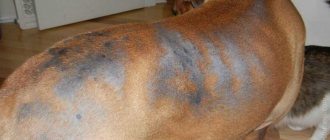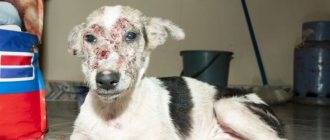Causes
Eczema in dogs occurs in acute, subacute and chronic forms, and can be dry and weeping. Each of the forms is either diffuse (with a large area affected) or localized (limited). In its chronic form, eczema is often dry; there are also periwound eczema, neuropathic (due to stress), and paratraumatic (after extensive injuries).
Reasons for development:
- The effect of negative factors. Poor dog care, dirt, lack of hygiene and washing days. Pets who spend a long time outdoors are more likely to experience interdigital pyoderma due to constant contact with dust, snow and salt, and freezing of wet paws. Eczema occurs in dogs with dense hair on their paws in the spaces between the toes and between the plantar pads (black terriers, poodles), when the owners do not wash their paws well after a walk and do not dry them completely. The skin under the fur begins to become wet, and an area of eczema forms. At this point, the skin cracks and ichor is released, which becomes an excellent breeding ground for bacterial and fungal microflora.
- Chemical reagents. Often a person, having read glossy magazines, believes that for the canine family, using a lot of cosmetics is a way of life. Undoubtedly, a dog that smells like a dog with a lump of matted tangles instead of fur is a bleak picture. But also the use of gels, oils for skin and wool, perfumes, powders, etc. Cosmetics options are not helpful. The dog's skin without sweat glands, the owner's excessive love for glamor is fraught with the appearance of peeling, redness and loss of protective properties.
- Allergic dermatitis. It can act as a reaction of the body to smells and food. An animal’s sense of smell is several times finer than that of a human, and what the owner considers pleasant acts as a “gas attack” for the pet. You need to think several times before using fragrances and cigarettes indoors. Do not wash dog beds with strong scents. Some foods cause signs of allergic dermatitis, which manifests itself as eczema. In this case, it is enough to change your diet and everything will return to normal.
- Cutaneous and subcutaneous parasites. Ticks, lice, lice, and fleas almost always provoke eczema, manifested by itching, scratching, and the addition of a bacterial infection. Diseases such as sarcoptic mange and demodectic mange act as intradermal parasites; when mites multiply, excellent conditions are created for the development of staphylococci and micromycetes, which, in turn, cause severe inflammation.
- Hyperthermia. Or the impact of high temperatures on the dog’s body. Many dog breeds are contraindicated from being in the sun for a long time (pit bull, labrador, brachycephalic, etc.); almost all dogs prefer to lie down in cool places in the heat. The owners make a mistake when they walk in open spaces when the temperature outside is high, when they take their pets to the beach, where they have nowhere to hide from the heat. A common mistake is to leave an animal in a car under the scorching rays of the sun in a tightly closed cabin; this is fraught not only with the appearance of skin pathologies, but also with death.
- Hormonal disorders. A sign of endocrinological disorders in the body is the appearance of dry eczema on the skin.
- Stress factors. Typically, neuropathic eczema develops with prolonged exposure to stress and is chronic.
- Diseases of internal organs. The most common cause of eczema is a violation of the blood supply to the skin. Localized areas of the dermis die, and when bacteria join, the disease worsens.
- Bacterial infections. Leptospirosis and disruption of capillary blood flow contribute to necrosis of the dermis and mucous membranes with the subsequent formation of eczema.
According to practical observations, its causes are not fully understood, but a large percentage is attributed to pathologies of the nervous system. Even the role of endocrine diseases is considered as their effect on the central nervous system with disruption of sympathetic and neurotrophic regulation.
Prevention measures
Eczema can be prevented. To do this you need:
- Monitor the animal's diet.
- Take proper care of your dog, make sure that it does not overheat or freeze.
- If there is a hereditary predisposition to the disease, regularly visit the veterinarian and examine the general condition of the pet. This will allow us to timely identify the factors that provoke the development of the disease and neutralize them.
- Make sure that accessories - collar, leash - do not injure the dog’s skin. Against the background of these factors, dermatitis develops, which can subsequently develop into eczema.
- Conduct deworming in a timely manner, give the necessary vaccines, and also get rid of skin parasites.
- Treat metabolic diseases, infectious pathologies.
It is also important for the dog owner to monitor its condition. If any suspicious symptoms appear: a rash and red spots on the face or in the interdigital space, you should immediately contact a veterinarian for a full examination and appropriate treatment. This is the only way to save your pet from protracted serious illnesses.
Types of eczema
When diagnosing, two types of eczema are distinguished - dry and weeping. Both types of manifestation of pathology are different in external appearance, location, shape and age of the dog.
getting wet
Its appearance is unpleasant, more like an open wound with characteristic contents. At first, the breeder does not attach any importance to the inflammation that appears, especially if it is hidden under thick and long hair. Gradually, severe irritation develops on the upper layer of the dermis with the formation of papules, vesicles with transparent (serous) contents on the surface.
The opening of the bubbles is accompanied by the release of fluid and the formation of open wounds. Almost always they are contaminated with bacteria, and a secondary pathological process develops with severe suppuration.
What is eczema in dogs: explanations and photos
Eczema is a type of inflammation that occurs on the epidermis (outer layer of skin) and gradually spreads to deeper layers. Dog hair masks the lesion for a long time, preventing its detection at the initial stage. Despite this, inflammation always occurs due to internal and external irritants, which means it can be prevented.
The inflammatory process is accompanied by the appearance of ulcers, roseola (rash), papules or vesicles (bubbles with liquid). Depending on the number of rashes, eczema can be monomorphic (only one type) and polymorphic (several types at the same time).
Chronic form
When the disease enters the chronic stage, they speak of a severely advanced version of eczema. The skin changes, coarsens, becomes thickened, loose. In essence, the dog resembles a bald creature covered with thick scabs.
Chronic eczema “loves” secluded places, where there are many folds (under the ears) or in places where the skin is most exposed to mechanical stress (paws, back, butt, etc.).
In dogs after 6-8 years of age and older, the risk of developing chronic eczema increases significantly. In pets with a highly developed undercoat and folded skin, the likelihood of developing various forms of eczema becomes higher.
Influence of factors on the development of pathology
Dry eczema after injury
- improper care of the pet, including lack of regular washing of the skin, fur, grooming;
- unbalanced diet, giving food of poor quality or causing allergies;
- breed tendency to allergic reactions;
- increased moisture in the folds of the skin in “folded” dogs (Shar-Pei);
- regular overfeeding or, conversely, hunger;
- low immunity;
- prolonged stress, provoking neuropathic eczema.
When diagnosing, it is necessary to take into account the likelihood of internal pathologies, including those that lower immunity. Hormonal imbalances, increased or decreased secretion of sebum, metabolic disorders - all this can indirectly provoke the formation of erythema and, then, eczema plaques.
Symptoms and diagnosis
In most cases when owners contact a veterinary clinic regarding a dog’s appearance, diagnosis does not present any problems. Symptoms for different forms:
- Weeping eczema looks like a torn area of the dermis. At an early stage, several wet spots appear, which gradually merge into one. The coat thins and falls out; if the hairs remain in the area of eczema, they are weak and dull. The lack of treatment for eczema in dogs provokes new “boiling” (from the Greek eczema - to boil) spots with bubbles. They rupture, forming “serous wells,” deepened tubules in the skin with leaking fluid. It is these “wells” that do not allow the wound surface to heal; the skin becomes swollen, very loose with a grayish-yellowish crust.
- With dry and chronic eczema, the symptoms are less frightening, but this does not mean that they do not require attention. The roughened area of skin is covered with scales or becomes shiny, glossy, and taut. The skin cracks, and flakes of dead scales constantly form along the edges of the eczema. Sometimes dry eczema is accompanied by a rash, redness, and pinpoint hemorrhages.
Important! With dry eczema, the dog is constantly worried, the skin is very itchy, but itching cannot be interpreted as the main sign of the disease.
List of symptoms characteristic of various stages of eczema development:
- Erythema of the skin with an increase in temperature at the site of formation of the pathological focus, itching, scratching and, as a logical conclusion, contamination with bacterial microflora and suppuration.
- The papular stage is the appearance of papules, cavityless formations the size of a pinhead with a pinkish-red tint, on the swollen area. Sometimes the disease freezes at this stage, the swelling decreases, new papules do not form, and the existing ones become covered with a dried crust.
- The vesicular form is characterized by an increase in inflammation and stimulation of outflow. In place of the papules, vesicles form, which burst and their contents flow out.
- The stage of formation of pustules or bright red erosions with oozing exudate is characteristic of weeping eczema. The fur partially falls out, the remaining strands are glued together with pus.
- The last two stages are crusty and scaly. With a favorable course of the disease and appropriate treatment, one can hope for a complete recovery and restoration of the coat.
The symptoms described above usually last for 2-4 weeks, but if the dog owner ignores them or refuses to follow all the veterinarian's recommendations, the disease may become stuck at one of the stages. In case of relapses, eczema forms again in an existing area, and changes in the skin become irreversible.
Acanthosis is a condition that appears in the chronic form of eczema. The cells of the spinous layer of the dermis multiply. Parakeratosis is the absence of a granular layer in the epidermis.
Diagnostic features
In practice, it is very difficult to establish the true cause of eczema. An accurate diagnosis can only be made by a veterinarian based on an examination of the pet and laboratory tests (cytological, blood, smear, etc.).
Important! Often, veterinary specialists receive calls or questions on websites describing the external signs of a certain condition and the eternal question “what is it and how to treat it.” Eczema is never diagnosed or treated without close doctor-animal contact. If you neglect this rule, then you cannot expect successful therapy.
It is necessary to distinguish eczema from the symptoms of trichophytosis, scabies or demodicosis. With scabies and demodicosis, mites are found in skin scrapings or exudate, the disease is quickly transmitted to other animals, while eczema is not contagious.
Clinical picture of the disease
In rare cases, the owner notices swelling and redness of the skin at the very beginning of the development of eczema. But this is possible either with a daily examination of the pet, or in a dog with a small amount of hair. Under a thick cover, the erythema is practically invisible.
What you need to pay attention to:
- severe scratching in the same place, sometimes the animal even whines from pain and itching;
- the wool in the places where it has been brushed is untidy, felted, dirty;
- alopecia (bald spots) often form;
- reddened, swollen, pimply patches of baldness appear;
- local skin temperature is increased.
The dog does not allow you to examine the site of the pathology; it snaps if you touch the inflamed skin. Sometimes there may be no characteristic redness of the dermis; on the contrary, it becomes excessively pale, thick, rough and scaly. This clinical picture is characteristic of dry eczema.
It is important to know! Dogs do not have sweat glands throughout their bodies; if the breeder notices that moist spots are forming under the fur, in the folds, and the skin feels worn out to the touch, this is the beginning of the development of weeping eczema. Therefore, folded pets must be wiped inside the folds 1-2 times a week, and when bathing they are thoroughly wiped and dried.
Possible complications
If eczema is not treated, the disease spreads to large areas of healthy skin, forming non-healing wounds, ulcers, and thickened skin. Pets become almost bald, covered with scabs. In addition to losing their external aesthetic appearance, they develop internal diseases and their immunity decreases. The once healthy and full of energy dog becomes apathetic, emaciated, eats poorly, refuses to communicate and play actively.
Is it transmitted to humans?
Eczema cannot be considered a contagious disease and is not transmitted through contact with people, things or other animals. This is a purely personal cross for the dog, although its appearance scares off people who believe that it is better to stay away from the animal.
Recommendations for owners
It is unlikely that you will be able to protect your beloved pet from eczema 100 percent. But you can minimize the risks. To do this you need:
- bathe the dog regularly, but not very often, wiping the fur and skin dry;
- monitor the diet so that it is balanced - a sufficient amount of micro- and macroelements, vitamins;
- regularly deworm your pet;
- make sure that the collar, harness and muzzle do not rub the skin, protect the dog from injury;
- reduce the possibility of stress;
- It is planned to visit the veterinarian at least three times a year.
Proper care, nutrition and attention will allow your pet to always be in a good mood. A happy dog is a healthy dog. And then no skin diseases, or any others, will be scary. But if your pet suddenly gets sick, you should immediately consult a doctor, who will prescribe treatment and make recommendations for further prevention of the disease and rehabilitation of the pet.
Treatment
Treatment for eczema is important and necessary; there is no one magic pill that you can give to your pet, and all problems will be solved by themselves.
The therapy is of a course nature, which means that you will have to influence not only the eczema itself, but also the reasons that provoked it. And sometimes this is the most difficult thing, since a dog can begin to itch due to an allergy, and the allergen is very difficult to identify, and due to other factors that a person often does not want to eliminate for various reasons.
Approximate treatment plan:
- Prescription of antiallergic drugs.
- Using autohemotherapy or subcutaneous injection of the dog's own blood.
- A diet with a decrease in meat products and an increase in plant and dairy feeds.
- Taking vitamins. It has been proven that the greatest effectiveness is shown by the use of vitamin A.
- External agents (Levomekol, Indomethacin ointments).
It is strictly forbidden to treat eczema yourself using medications available in your home medicine cabinet. Without strict adherence to the treatment regimen and compliance with the veterinarian’s instructions, the disease is difficult to cure.
With eczema, the body quickly becomes accustomed to drugs for local treatment (creams, ointments), so the veterinarian periodically changes the treatment regimen.
Drying agents are used for weeping eczema, and moisturizers for dry eczema to prevent cracks. In case of secondary contamination with bacteria, antibacterial ointments are prescribed to speed up healing, and regenerating medications are used.
Hormonal preparations in the form of ointments and powders are necessary for extensive lesions and in the absence of results from treatment with easier means.
Antipruritic medications (Stop Itch spray) are required; they reduce the likelihood of injury to eczema foci, and painkillers so that the pet can tolerate unpleasant symptoms.
Folk recipes
They are used as an aid to the main course of therapy; their use must be coordinated with the attending physician.
Examples:
- Burdock leaf ointment. Popular for chronic dry eczema. The pulp is mixed with glycerin and applied to the dog’s skin twice a day.
- Mass of viburnum or strawberries. Removes redness, relieves itching.
- Cabbage leaf and tar.
- Elecampane decoction (2 tbsp per half liter of water).
- Powder of starch and iodine.
Essentially, this treatment is aimed at relieving symptoms rather than treating the eczema itself. For treatment to be successful, it is important to direct all efforts to eliminate the cause of the disease!
How and with what to treat eczema in a dog
Complex treatment involves combining external treatment of wounds and ulcers with internal medication. It is selected individually, taking into account the age of the animal, the type and cause of the pathology.
Medicines, ointments and sprays
If there is copious discharge of serous or purulent fluid, infusion therapy (droppers) with sodium bromide, calcium chloride or sodium hyposulfite is carried out. If abnormalities in the liver are detected, hepatoprotectors are prescribed without fail. Severe anemia is eliminated with blood transfusions and immunomodulators.
The choice of medications depends on the form of pathology:
- Dry
. Treat with glucocorticosteroids (Dermozolon, Fluorocort, Cortomycetin) and antihistamines (Suprastin, Diphenhydramine). The skin is moisturized with special shampoos, gels, ointments and sprays. When choosing a product, it is important to combine an anti-inflammatory and antibacterial effect to avoid secondary infection.
- getting wet
. Eliminate with antibiotics (Sinulox, Erythromycin), which are used in combination with sorbents. To treat wounds, tar soap, Lassar paste, Salicylic acid and Terramycin spray are used, which help restore the skin and protect against re-infection.
Pain is relieved with painkillers and novocaine blockade. To relieve stress, sedatives with a calming effect are prescribed. For the entire duration of treatment, the pet must wear a protective collar to prevent licking of ointments and scratching of wounds.
Eliminate the root cause
After identifying the cause of the disease, it is necessary to eliminate it. To do this you will have to:
- treat the animal for external or internal parasites;
- regularly carry out not only dry, but also wet cleaning, paying special attention to the sleeping area and feeding troughs;
- take care to create a comfortable environment in the house, eliminating dampness, cold and too high temperatures;
- protect your pet from exposure to ultraviolet radiation and direct sunlight;
- change care products by choosing veterinary hypoallergenic products;
- refuse aggressive household chemicals;
- Change a collar or harness that causes contact damage.
Additionally, the dog is prescribed therapeutic diets and special procedures. It is necessary to care for the affected skin on the paws, abdomen, ears and other affected areas until the skin is completely restored.
Diet and care
To regenerate the skin, foods containing large amounts of sulfur, cobalt and zinc are introduced into the diet. Amino acids include methionine and cysteine. Meat and offal are temporarily limited, with an emphasis on dairy and plant foods.
After carefully cutting off the fur, the areas of inflammation are treated with special sterile wipes, and the dried crusts are soaked with chlorhexidine. Additionally, the surface is treated with ichthyol, zinc or xeromorphic ointments that absorb seals. Among folk remedies, it is permissible to use freshly squeezed plantain juice, honey, decoctions of celandine, nettle, burdock and string. All medications are prescribed by a veterinarian.
Duration of treatment
The treatment period takes from 2 weeks to several months. The duration depends on the severity of the pathology and compliance with medical recommendations. If the owner stops care immediately after the first improvements, then in the future the disease may worsen and become chronic.
Therapeutic diet
First of all, if the cause of the development of eczema is food, it is removed from the dog’s diet. For overly sensitive pets, industrial food with a hypoallergenic composition and vitamin A is recommended.
The menu includes butter (not margarine or palm oil), beef and chicken liver (raw) - they are also a source of vitamin A.
Cereals, vegetables, and dairy products perform well, but you need to be careful with excess chicken as a protein (including in dry food). Practice proves that skin problems occur more often in those dogs whose diet is dominated by chicken. It is better to replace it with turkey.
Etiology and pathogenesis
The nervous and endocrine systems, acting pathologically on internal organs, cause disruption of neurotrophic regulation. As a result of poor functioning of the endocrine glands, endo- and exo-irritants, a kind of sensitization occurs in the dog’s body, leading to diseases of the dermis.
Normally, toxins that are formed in the intestines and stomach are removed from the body by the kidneys and detoxified in the liver. In diseases of these organs, they accumulate in large quantities in the skin and are excreted through it.
Difference between weeping and dry eczema
Dogs, like humans, can have a wet or dry type of the disease. Both types of disorders can affect a pet, regardless of what caused the disease in the first place. Often the dry form turns into a wet form and vice versa.
Neuropathic eczema of wet type
With dry eczema, extensive patches of skin form on the skin, which actively peels off. The exudate released from the vesicles dries immediately without causing additional irritation to the skin. This form is the easiest to treat and rarely provokes acute inflammatory processes.
Dry eczema heals faster than wet eczema
With the wet type of disorder, the dog constantly notices moisture in the affected area. The exudate released from the blisters does not dry out and causes additional trauma and irritation of the epidermis. This form often provokes a secondary infection and is difficult to treat.
For what reasons can a pet get sick?
The development of this disease is facilitated by a number of factors, including:
- damage to the skin - cuts, lacerations, burns (including sunburn);
- a large number of parasites on the animal’s body (ticks, fleas);
- exposure to toxic substances on the skin, including gasoline, kerosene;
- systemic diseases;
- vitamin deficiency, as well as metabolic disorders;
- parasitic pathologies;
- vegetative deviations.
Other causes of eczema include hereditary predisposition, stress, poor diet, excess weight, and bacterial infections. In some cases, the disease can be caused by several factors. It is in the interests of the dog breeder to identify them and select the correct treatment regimen for the animal. If a person cannot determine which factor provoked the development of the pathology and does not limit its effect on the pet’s body, he will not be able to achieve a lasting therapeutic effect from the treatment.










